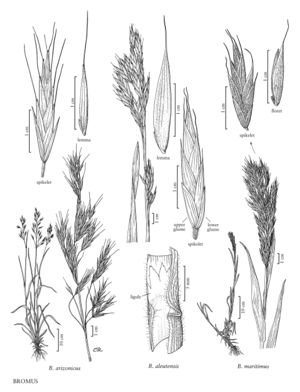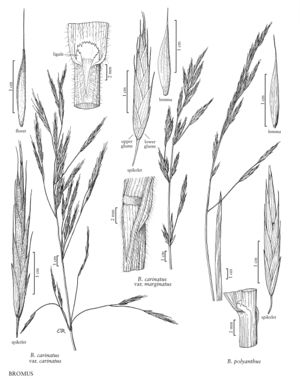Plants perennial, annual, or biennial; usually cespitose, sometimes rhizomatous. Culms 5-190 cm. Sheaths closed to near the top, usually pubescent; auricles sometimes present; ligules membranous, to 6 mm, usually erose or lacerate; blades usually flat, rarely involute. Inflorescences panicles, sometimes racemes in depauperate specimens, erect to nodding, open to dense, occasionally 1-sided; branches usually ascending to spreading, sometimes reflexed or drooping. Spikelets 5-70 mm, terete to laterally compressed, with 3-30 florets; disarticulation above the glumes, beneath the florets. Glumes unequal, usually shorter than the adjacent lemmas, always shorter than the spikelets, glabrous or pubescent, usually acute, rarely mucronate; lower glumes 1-7 (9) -veined; upper glumes 3-9 (11) -veined; lemmas 5-13-veined, rounded to keeled, glabrous or pubescent, apices entire, emarginate, or toothed, usually terminally or subterminally awned, sometimes with 3 distinct awns or unawned; paleas usually shorter than the lemmas, ciliate on the keels, adnate to the caryopses; anthers (2) 3. x = 7.
Distribution
Conn., Mass., N.H., N.J., N.Y., Calif., Del., N.C., Va., W.Va., Vt., D.C, Wis., Colo., Kans., Nebr., Okla., Idaho, Mont., Oreg., Wash., Wyo., Pacific Islands (Hawaii), N.Mex., Utah, Maine, R.I., Fla., Ala., Ark., Ariz., Ga., Iowa, Ill., Ind., Ky., La., Md., Mich., Minn., Mo., Miss., N.Dak., Nev., Ohio, Pa., S.Dak., Tenn., Tex., Alaska, S.C., Alta., B.C., Greenland, Man., N.B., Nfld. and Labr., N.S., N.W.T., Nunavut, Ont., P.E.I., Que., Sask., Yukon
Discussion
Bromus grows in temperate and cool regions. It is estimated to include 100-400 species, the number depending on how the species are circumscribed. Of the 52 species in the Flora region, 28 are native and 24 are introduced. The native perennial species provide considerable forage for grazing animals, with some species being cultivated for this purpose. The introduced species, all but three of which are annuals, range from sporadic introductions to well-established members of the region's flora. Many are weedy and occupy disturbed sites. Some are used for hay; others have sharp, pointed florets and long, rough awns that can injure grazing animals.
This treatment is based on one submitted by Pavlick, who died before it could be reviewed and edited. It has been substantially revised by Anderton to meet the requirements for publication in this volume. The majority of Pavlick's taxonomic concepts are retained, despite the necessity for overlap in many key leads; time constraints prevented a thorough investigation of problematic taxa. The treatment recognizes taxa at both the subspecies and varietal rank; this simply reflects the decisions of the original author. We thank Hildemar Scholz of the Botanic Garden and Botanical Museum Berlin-Dahlem, Free University Berlin, for providing accurately identified specimens of the weedy European species for use in preparing the illustrations, and for his helpful suggestions for the keys and descriptions.
In the keys and descriptions, the distances from the bases of the subterminal lemma awns to the lemma apices are measured on the most distal florets in a spikelet.
Selected References
Lower Taxa
Key
| 1 | Lemmas strongly keeled, at least distally; spikelets strongly laterally compressed; lower glumes 3-7(9)-veined | Bromus sect. Ceratochloa |
| 1 | Lemmas rounded over the midvein; spikelets terete to moderately laterally compressed; lower glumes 1-5-veined. | > 2 |
| 2 | Awns, if present, arising less than 1.5 mm below the lemma apices; lemma apices entire, emarginate, or with teeth less than 1 mm long. 3. Lower glumes 1-3-veined; upper glumes 3-5-veined; plants perennial or annual, if annual, the lower glumes 1-veined and the upper glumes 3-veined | Bromus sect. Bromopsis |
| 3 | Lower glumes 3-5-veined; upper glumes 5-9-veined; plants annual or biennial, if biennial, the upper glumes 7-veined and/or the lateral veins of the lemmas prominently ribbed | Bromus sect. Bromus |
| 2 | Awns arising 1.5 mm or more below the lemma apices, lemma apices entire, emarginate, or with teeth to 5 mm long. | > 3 |
| 4 | Awns usually geniculate, sometimes only divaricate, lemma teeth 2-3 mm long, usually aristate, sometimes only acuminate | Bromus sect. Neobromus |
| 4 | Awns straight, arcuate, or divaricate, not geniculate, sometimes absent; lemma teeth absent or to 5 mm long, acuminate. | > 5 |
| 5 | Lower glumes 1-3-veined; upper glumes 3-5-veined; spikelets with parallel or diverging sides in outline, often widening distally; lemma apices bifid, teeth (0.8)1-5 mm long | Bromus sect. Genea |
| 5 | Lower glumes 3-5-veined; upper glumes 5-9-veined; spikelets with parallel or converging sides in outline; lemma apices entire to bifid, teeth less than 1 mm long, apices sometimes split and teeth appearing longer | Bromus sect. Bromus |
"decumbent" is not a number.


